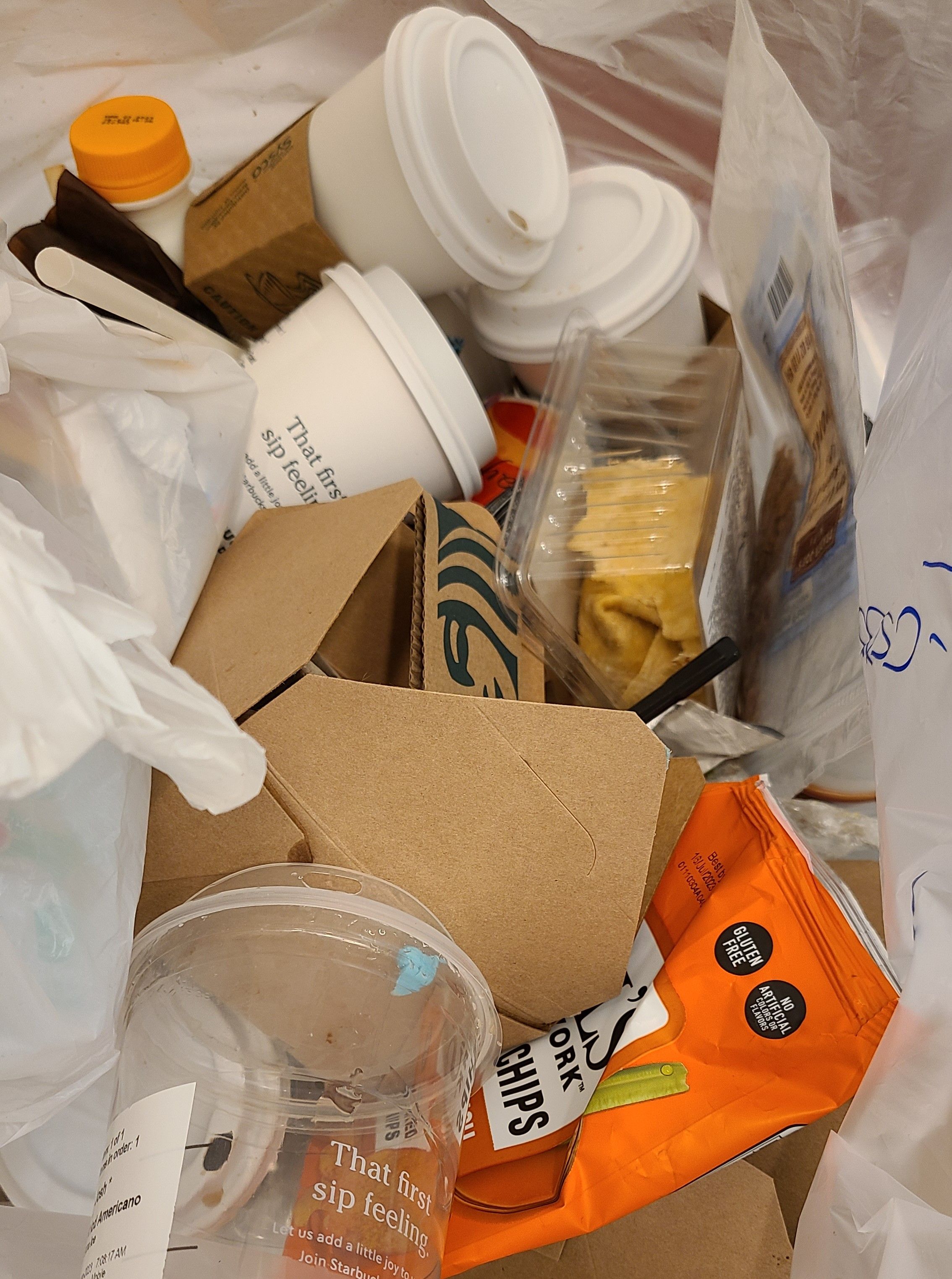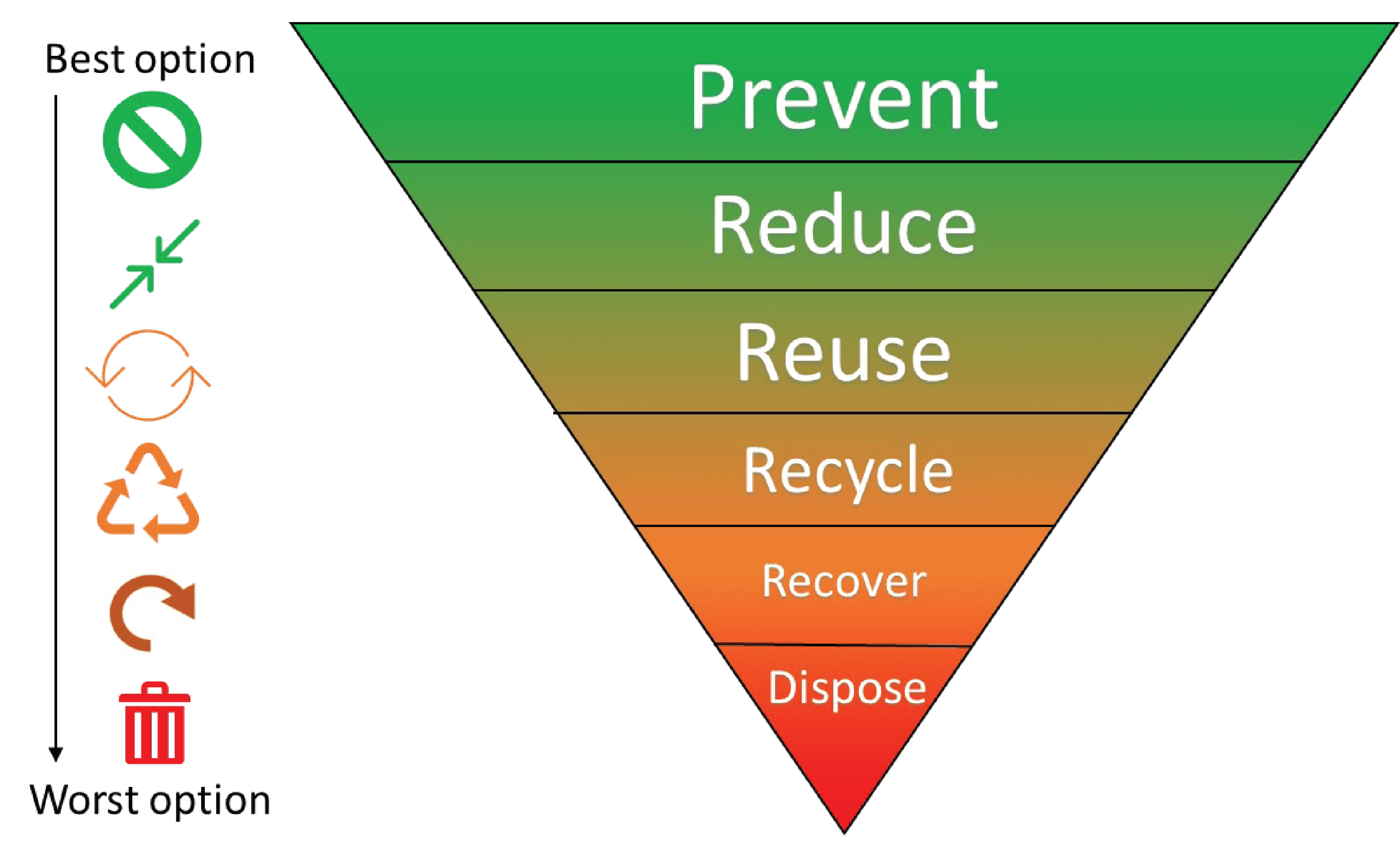Earth Day was founded in 1970. U.S. Senator Gaylord Nelson of Wisconsin called for a nationwide demonstration in the spring of 1970 aimed to raise awareness of environmental issues. It worked. The first national Earth Day was April 22, 1970.

Inside a contaminated recycling bag.
Housekeeping collects the waste every evening (twice per day in 24/7 areas). For practicality, housekeepers use the same wheeled receptacle to collect both trash and recycling. The bags are then visually sorted into trash or recycling streams based on the content. If a bag of recycling is clean, it will be sent for recycling. If it has contamination of materials that shouldn't be there, it will be treated as trash.
Waste Streams Life Cycle
Trash

Once solid trash is picked up from our buildings, it is brought to waste transfer facilities by the haulers. From here, it is distributed to landfills, usually in Pennsylvania or Virginia.
Recycling

Paper: At a material recovery facility, paper is sorted and baled by grades, such as sorted office paper (SOP), mixed office paper (MOP), and old corrugated cardboard (OCC). These bales are shipped by rail, truck, and overseas container to fiber recycling plants. SOP is sent to mills in NY, NJ, and Canada, where it is made into hand towels and toilet tissue. MOP is sent to mills in Staten Island, NY, and Philadelphia, PA, where it is made into pizza boxes and other packaging items. Note: keeping paper separated from the rest of the recycling keeps the scrap material clean, whereas it could get contaminated if mixed with the rest of the recycling.
Plastic: Rigid plastic (such as empty bottles or cups, clean containers, caps and lids) is sorted by resin type (PET, HDPE, LDPE, etc.), baled, and shipped to several U.S. and Canadian mills. PET can be made into fleece sweatshirts. The most-often recycled plastic, HDPE #2, is recycled into plastic lumber, tables, benches, truck cargo liners, trash receptacles, stationery, and other durable plastic products.
Metal: Metal is sorted in open-top containers and taken to various scrap metal facilities for intermediary ferrous and non-ferrous sorting and processing before being sold to foundries for smelting. For example, aluminum cans are shredded or ground into small chips before being melted and cast into ingots, which are sent to manufacturing plants where they are used to manufacture end products such as cans, castings, and car bodies.
Glass bottles: Glass bottles are sorted by color (e.g., clear, brown, and green) and sent to processing facilities where they are broken down into small pieces and separated from metals, labels, bits of plastic, metal rings, and caps. Glass is then blended with silica sand, soda ash, and limestone, and melted into molten glass.
Cardboard

Old, corrugated cardboard is sent to mills in India and Southeast Asia, where it is made into brown shipping boxes. Note: keeping it separated from the rest of the recycling keeps the scrap material clean, whereas it could get contaminated if mixed with the rest of the recycling.
Confidential Documents & Shredded Paper

Confidential documents, if not already shredded, are shredded on-site by our hauler USA Shred and then brought to a material recovery facility for recycling.
Bulk Waste

Note: Before disposal, oil and CFCs need to be reclaimed from refrigerators, freezers, A/C units, etc.
Bulk waste is collected into dumpsters which are brought by the hauler to bulk and construction & demolition (C&D) debris recovery facilities. Wood and C&D debris is sorted, recovered, and turned into mulch, construction filler, and composite board and reused in the construction of crating, planking, and refurbishing pallets/skids.
Regulated Medical Waste

For more details regarding regulated medical waste, please visit the EHS site. Regulated medical waste is autoclaved before being dumped into a landfill.
Hazardous Waste (chemicals, chemotherapeutics, regulated substances, expired medications)

Hazardous waste is incinerated before reaching a landfill. Lendfills used for hazardous waste are specialized for this purpose and are not the same as landfills for standard waste.
Universal Waste (batteries, mercury, lamps, waste oil)

The majority of universal waste can be recycled.
Electronics

WCM uses a third party vendor to reuse and recycle as much electronics as possible.
You can help us reduce waste and improve diversion rates before you recycle.
- Preventing waste from entering our campus (do you really need that extra shopping bag? Can you bring your own?)
- Reducing the amount of waste you generate (choose a product with less packaging)
- Reusing (bring your own reusable water bottle and cup)

